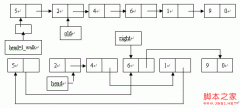C++数据结构学习之队列的应用
在学习C++队列的运用中,我看了两本书,都是讲解队列应用的,而且都是银行营业模拟。细比较,这两本书模拟的银行营业的方式还是不同的。老式的营业模式,现在的很多地方还是这种营业模式——几个窗口同时排队。这种方式其实不太合理,经常会出现先来的还没有后来的先办理业务(常常前面一个人磨磨蹭蹭,别的队越来越短,让你恨不得把前面那人干掉)。另一种营业模式——挂牌的营业方式,每个来到的顾客发一个号码,如果哪个柜台空闲了,就叫号码最靠前的顾客来办理业务;如果同时几个柜台空闲,就按照一种法则来决定这几个柜台叫号的顺序(最简单的是按柜台号码顺序)。这样,就能保证顾客按照先来后到的顺序接受服务——因为大家排在一个队里。这样的营业模式我在北京的西直门工商银行见过,应该说这是比较合理的一种营业模式。
我按照实际情况模拟,实现如下:
- #ifndef Simulation_H
- #define Simulation_H
- #include <iostream.h>
- #include <stdlib.h>
- #include <time.h>
- class Teller
- {
- public:
- int totalCustomerCount;
- int totalServiceTime;
- int finishServiceTime;
- Teller() :totalCustomerCount(0), totalServiceTime(0),
- finishServiceTime(0) {}
- };
- //#define PRINTPROCESS
- class Simulation
- {
- public:
- Simulation()
- {
- cout << endl << "输入模拟参数" << endl;
- cout << "柜台数量:"; cin >> tellerNum;
- cout << "营业时间:"; cin >> simuTime;
- cout << "两个顾客来到的最小间隔时间:"; cin >> arrivalLow;
- cout << "两个顾客来到的最大间隔时间:"; cin >> arrivalHigh;
- cout << "柜台服务最短时间:"; cin >> serviceLow;
- cout << "柜台服务最长时间:"; cin >> serviceHigh;
- arrivalRange = arrivalHigh - arrivalLow + 1;
- serviceRange = serviceHigh - serviceLow + 1;
- srand((unsigned)time(NULL));
- }
- Simulation(int tellerNum, int simuTime, int arrivalLow, int arrivalHigh, int serviceLow, int serviceHigh)
- : tellerNum(tellerNum), simuTime(simuTime), arrivalLow(arrivalLow), arrivalHigh(arrivalHigh),
- serviceLow(serviceLow), serviceHigh(serviceHigh),
- arrivalRange(arrivalHigh - arrivalLow + 1), serviceRange(serviceHigh - serviceLow + 1)
- { srand((unsigned)time(NULL)); }
- void Initialize()
- {
- curTime = nextTime = 0;
- customerNum = customerTime = 0;
- for (int i = 1; i <= tellerNum; i++)
- {
- tellers[i].totalCustomerCount = 0;
- tellers[i].totalServiceTime = 0;
- tellers[i].finishServiceTime = 0;
- }
- customer.MakeEmpty();
- }
- void Run()
- {
- Initialize();
- NextArrived();
- #ifdef PRINTPROCESS
- cout << endl;
- cout << "tellerID";
- for (int k = 1; k <= tellerNum; k++) cout << "tTELLER " << k;
- cout << endl;
- #endif
- for (curTime = 0; curTime <= simuTime; curTime++)
- {
- if (curTime >= nextTime)
- {
- CustomerArrived();
- NextArrived();
- }
- #ifdef PRINTPROCESS
- cout << "Time: " << curTime << " ";
- #endif
- for (int i = 1; i <= tellerNum; i++)
- {
- if (tellers[i].finishServiceTime < curTime) tellers[i].finishServiceTime = curTime;
- if (tellers[i].finishServiceTime == curTime && !customer.IsEmpty())
- {
- int t = NextService();
- #ifdef PRINTPROCESS
- cout << 't' << customerNum + 1 << '(' << customer.GetFront() << ',' << t << ')';
- #endif
- CustomerDeparture();
- tellers[i].totalCustomerCount++;
- tellers[i].totalServiceTime += t;
- tellers[i].finishServiceTime += t;
- }
- #ifdef PRINTPROCESS
- else cout << "t ";
- #endif
- }
- #ifdef PRINTPROCESS
- cout << endl;
- #endif
- }
- PrintResult();
- }
- void PtintSimuPara()
- {
- cout << endl << "模拟参数" << endl;
- cout << "柜台数量: " << tellerNum << "t营业时间:" << simuTime << endl;
- cout << "两个顾客来到的最小间隔时间:" << arrivalLow << endl;
- cout << "两个顾客来到的最大间隔时间:" << arrivalHigh << endl;;
- cout << "柜台服务最短时间:" << serviceLow << endl;
- cout << "柜台服务最长时间:" << serviceHigh << endl;
- }
- void PrintResult()
- {
- int tSN = 0;
- long tST = 0;
- cout << endl;
- cout << "-------------模拟结果-------------------";
- cout << endl << "tellerIDtServiceNumtServiceTimetAverageTime" << endl;
- for (int i = 1; i <= tellerNum; i++)
- {
- cout << "TELLER " << i;
- cout << 't' << tellers[i].totalCustomerCount << " "; tSN += tellers[i].totalCustomerCount;
- cout << 't' << tellers[i].totalServiceTime << " "; tST += (long)tellers[i].totalServiceTime;
- cout << 't';
- if (tellers[i].totalCustomerCount)
- cout << (float)tellers[i].totalServiceTime/(float)tellers[i].totalCustomerCount;
- else cout << 0;
- cout << " " << endl;
- }
- cout << "TOTAL t" << tSN << " t" << tST << " t";
- if (tSN) cout << (float)tST/(float)tSN; else cout << 0;
- cout << " " << endl;
- cout << "Customer Number:t" << customerNum << "tno Service:t" << customerNum - tSN << endl;
- cout << "Customer WaitTime:t" << customerTime << "tAvgWaitTime:t";
- if (tSN) cout << (float)customerTime/(float)tSN; else cout << 0;
- cout << endl;
- }
- private:
- int tellerNum;
- int simuTime;
- int curTime, nextTime;
- int customerNum;
- long customerTime;
- int arrivalLow, arrivalHigh, arrivalRange;
- int serviceLow, serviceHigh, serviceRange;
- Teller tellers[21];
- Queue<int> customer;
- void NextArrived()
- {
- nextTime += arrivalLow + rand() % arrivalRange;
- }
- int NextService()
- {
- return serviceLow + rand() % serviceRange;
- }
- void CustomerArrived()
- {
- customerNum++;
- customer.EnQueue(nextTime);
- }
- void CustomerDeparture()
- {
- customerTime += (long)curTime - (long)customer.DeQueue();
- }
- };
- #endif
几点说明
1、Run()的过程是这样的:curTime是时钟,从开始营业计时,自然流逝到停止营业。当顾客到的事件发生时(顾客到时间等于当前时间,小于判定是因为个别时候顾客同时到达——输入arrivalLow=0的情况,而在同一时间,只给一个顾客发号码),给这个顾客发号码(用顾客到时间标示这个顾客,入队,来到顾客数增1)。当柜台服务完毕时(柜台服务完时间等于当前时间),该柜台服务人数增1,服务时间累加,顾客离开事件发生,下一个顾客到该柜台。因为柜台开始都是空闲的,所以实际代码和这个有点出入。最后,停止营业的时候,停止发号码,还在接受服务的顾客继续到服务完,其他还在排队的就散伙了。
2、模拟结果分别是:各个柜台的服务人数、服务时间、平均服务时间,总的服务人数、服务时间、平均服务时间,来的顾客总数、没被服务的数目(来的太晚了)、接受服务顾客总等待时间、平均等待时间。
3、这个算法效率是比较低的,实际上可以不用队列完成这个模拟(用顾客到时间推动当前时钟,柜台直接公告服务完成时间),但这样就和实际情况有很大差别了——出纳员没等看见人就知道什么时候完?虽然结果是一样的,但是理解起来很莫名其妙,尤其是作为教学目的讲解的时候。当然了,实际中为了提高模拟效率,本文的这个算法是不值得提倡的。
4、注释掉的#define PRINTPROCESS,去掉注释符后,在运行模拟的时候,能打印出每个时刻柜台的服务情况(第几个顾客,顾客到达时间,接受服务时间),但只限4个柜台以下,多了的话屏幕就满了(格式就乱了)。
这是数据结构中第一个实际应用的例子,而且也有现实意义。你可以看出各个柜台在不同的业务密度下的工作强度(要么给哪个柜台出纳员发奖金,要么轮换柜台),各种情况下顾客的等待时间(人都是轮到自己就不着急了),还有各种情况下设立几个柜台合理(很少的空闲时间,很短的等待时间,几乎为零的未服务人数)。例如这样:
- for (int i = 1; i < 16; i++)
- {
- Simulation a(i,240,1,4,8,15);
- a.Run();
- }
你模拟一下就会得出,在不太繁忙的银行,4~5个柜台是合适的——现在的银行大部分都是这样的。
- 上一篇:C++数据结构学习之栈的应用
- 下一篇:如何在C++链表中链入不同类型对象





